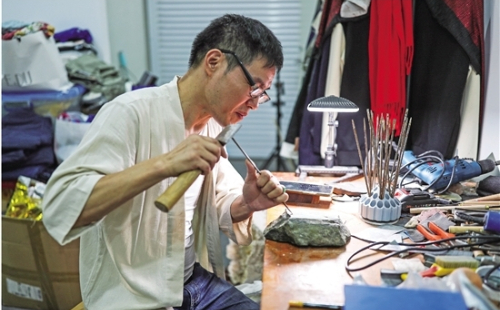Ink stone-carving: Artistry on the edge of a knife

Pan Ronggen carves an ink stone. [Photo/Zhejiang Daily]
The history of Shaoxing ink stones can be traced back over 2,000 years.
They originated in Shaoxing and thrived during the Tang (618-907) and Song (960-1279) dynasties. Their distinctiveness lies in their density and smooth texture, which grinds ink like lacquer, making it popular among scholars and literati alike.
Today, craftsman Pan Ronggen stands as the foremost artisan in crafting Shaoxing ink stones.
From the meticulous selection of raw materials to cutting and splitting and intricate processes such as composition and carving, Pan scrutinizes every detail.
He firmly believes that it is in the minutiae that the true essence of a piece is revealed. Additionally, finding the right ink stone is an art in itself. Pan often spends several months trekking through mountains and streams in the vicinity to select the finest materials.
In the recent 2nd Zhejiang Skills Competition, Pan, representing the city, participated in the exceptional skills demonstration section. He showcased his unparalleled ink stone carving skills in-person.
Pan is currently engaged in public performances and teaching in an effort to promote ink stones. His ultimate goal is to pass down the art of ink stone carving and promote Shaoxing’s traditional culture to the world.


 Shaoxing Showdowns
Shaoxing Showdowns Zhejiang: A Decade of Progress
Zhejiang: A Decade of Progress Shaoxing in expats' eyes
Shaoxing in expats' eyes